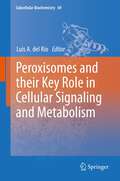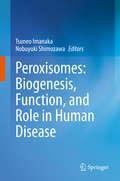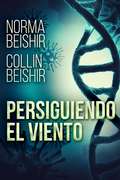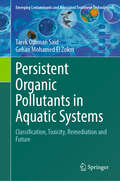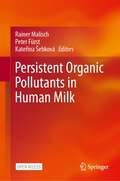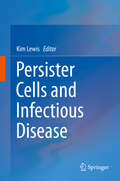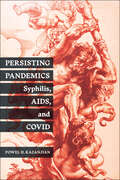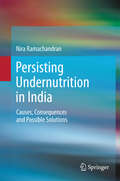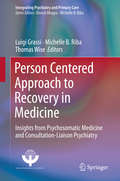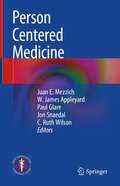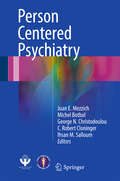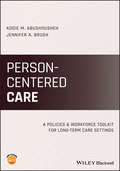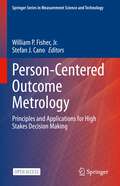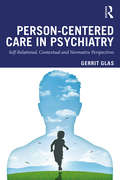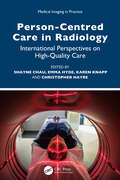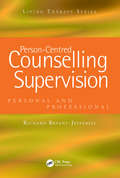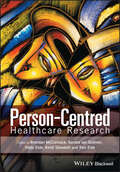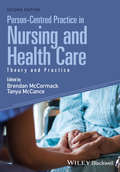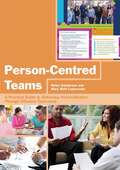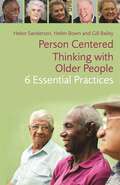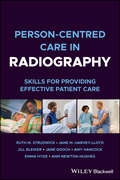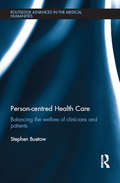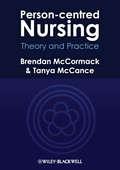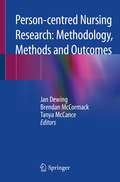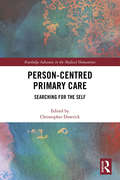- Table View
- List View
Peroxisomes and their Key Role in Cellular Signaling and Metabolism
by Luis A. del RíoPeroxisomes are a class of ubiquitous and dynamic single membrane-bounded cell organelles, devoid of DNA, with an essentially oxidative type of metabolism. In recent years it has become increasingly clear that peroxisomes are involved in a range of important cellular functions in almost all eukaryotic cells. In higher eukaryotes, including humans, peroxisomes catalyze ether phospholipids biosynthesis, fatty acid alpha-oxidation, glyoxylate detoxification, etc, and in humans peroxisomes are associated with several important genetic diseases. In plants, peroxisomes carry out the fatty acid beta-oxidation, photorespiration, metabolism of ROS, RNS and RSS, photomorphogenesis, biosynthesis of phytohormones, senescence, and defence against pathogens and herbivores. In recent years it has been postulated a possible contribution of peroxisomes to cellular signaling. In this volume an updated view of the capacity and function of peroxisomes from human, animal, fungal and plant origin as cell generators of different signal molecules involved in distinct processes of high physiological importance is presented.
Peroxisomes: Biogenesis, Function, and Role in Human Disease
by Tsuneo Imanaka Nobuyuki ShimozawaThis book provides readers with a comprehensive overview of peroxisomes and their role in human diseases. It starts by describing the history of peroxisome research and then examines in detail the current understanding of the biogenesis and function of peroxisomes. It then focuses on peroxisomal disorders and the involvement of peroxisomes in cancer and age-related diseases, discussing in detail the use of model organisms to elucidate the pathogenesis of peroxisomal disorders and the physiological importance of peroxisomal proteins. Further, the book examines diagnostic and therapeutic strategies in peroxisomal disorders as well as significant recent advances. Lastly, it addresses various topics in peroxisome research, including the isolation of peroxisomes from mammalian tissues and cells, the structural biology of peroxisomal proteins, the lipidomics of peroxisomal disorders, the value of exome sequencing, and neuropsychological testing in X-linked adrenoleukodystrophy. Given its scope, the book is a valuable resource for postgraduate students and researchers in the life sciences and clinicians in the fields of internal medicine, pediatrics, and neurology.
Persiguiendo El Viento
by Norma Beishir Collin BeishirCuando seis niños superdotados desaparecen alrededor del globo, una investigación revela experimentación genética, financiamiento dudoso y la desaparición de un asistente de investigación. En búsqueda de pruebas sobre el Éxodo, la Arqueólogo Biblica Lynne Raven conoce al enigmático heredero multimillonario Connor Mackenzie. Mientras la cercanía entre ambos crece, un perturbador vínculo con los secuestros y un pasado plagado de secretos, visiones y voces cambiará sus vidas. En búsqueda de la verdad, ¿podrán los dos descifrar el misterio de la profecía o se quedarán persiguiendo el viento?
Persistent Organic Pollutants in Aquatic Systems: Classification, Toxicity, Remediation and Future (Emerging Contaminants and Associated Treatment Technologies)
by Gehan Mohamed El Zokm Tarek Othman SaidThis book addressed an in-depth comprehension of the classifications and characterizations of POPs, which have become global issues due to bioaccumulation, persistency, and toxicity. It represents the milestones of the development of pesticide application, industry, and management. Banned SC-POPs have special investigations. It discusses air-sea exchange, ocean currents, phase distribution, speciation, adsorption, desorption, and degradation as the key processes that control POP's fate. The book explores several aspects of POP chemistry that have a direct influence on their biochemical and toxicological consequences. The book illustrates the dynamic equilibriums influencing the proportion of a POP's gaseous, liquid, and solid phases. The book discussed POP migration by referring to the grasshopper effect. It also explores the impacts of climate change on emissions and the fate of POPs through a global-scale multimedia fate model. Additionally, it displays the impact of potential global change scenarios on POP bioaccumulation patterns. The book is directed at giving a deep discussion of the method's QA/QC process for POP determination and has verified the accuracy and precision of the procedures. As a distinctive point, it discusses many aspects concerning the toxicity of POPs. It reports mechanisms describing the toxicity of POPs on immune systems, carcinogenesis, endocrine, neural, and reproductive systems. The book keeps an eye on a model describing the global distribution and toxicity of PAHs. Among the exclusive points in the book is the evaluation of the recent ecological status in Egypt relative to POPs through a time-scale overview and recent case studies. It provides thematic literature related to DDC research in Africa through the WoS and Scopus databases from 1949 to 2021. The book emphasizes models for predicting the annual contribution rate of POPs as a way to raise public awareness about POPs. The greatest challenge for the book is how to motivate the audience to be aware of these hazardous materials in marine ecosystems. Moreover, this book will be of great interest to academics, professionals, practitioners, post-graduate students, and undergraduates because it gives a clear overview of POPs in the marine environment. It also provides decision-makers with a realistic perspective of the environmental file, allowing them to address environmental issues and directing stockholders to safer locations for environmental activity. From a future perspective, the regulation of pervasive POPs, with special reference to recently evaluated harmful substances (PFASs), has faced significant challenges in the wake of pressure from regulators.
Persistent Organic Pollutants in Human Milk
by Peter Fürst Rainer Malisch Kateřina ŠebkováThis open access book reviews the trends of persistent organic pollutants (POPs) in human milk and discusses the main findings of five global surveys that were coordinated by the World Health Organization (WHO) and the United Nations Environment Programme (UNEP) from 2000 to 2019. Human milk was selected as core matrix for human exposure under the Global Monitoring Plan for effectiveness evaluation of the Stockholm Convention on Persistent Organic Pollutants. Milk from well-defined groups of mothers was collected and mixed to form a representative sample per country. Datasets collected represent the largest global human tissues survey with a harmonized protocol, carried out in a uniform format for more than two decades. Altogether 69 countries participated in these studies between 2000 and 2015, and more than 40 countries participated in the study from 2016 to 2019.Divided into 5 parts, the book offers an authoritative overview of human milk biomonitoring; collates the harmonized sampling requirements and analytical methods for the identification and quantification of contaminants in human milk; examines the results of the WHO/UNEP-coordinated exposure studies, including the identification of selected chlorinated pesticides, dioxin-like compounds, industrial chemicals like polychlorinated biphenyls (PCB) and chlorinated paraffins, polybrominated POPs and PFAS, among others; and traces geographic, temporal and cross-substance trends and correlations, and human health risks. The book finishes by providing the reader with the summary of the main findings and outlook from these studies, in which the comparison of concentrations found for the wide range of POPs listed in the Stockholm Convention allowed the identification of possible needs for actions and follow-ups in different countries/regions. This book contributes to the understanding of exposure to hazardous chemicals and pollution as addressed by the UN Sustainable Development Goals on Good Health and Well-being (SDG 3) and will appeal to environmental and analytical chemists, researchers, professionals, and policymakers interested in learning more about contaminants in human milk. Given its breadth, this book will also appeal to a broader audience interested in maternal and child health.
Persister Cells and Infectious Disease
by Kim LewisThis volume is a collection of chapters from the leading experts in the relatively new and burgeoning field of persister cell studies. Persisters play a leading role in the recalcitrance of chronic infections, and enable the development of classical antibiotic resistance. The focus of the book is on studies that provide an understanding of the mechanisms of persister formation, antibiotic tolerance and role in disease, at the molecular level.
Persisting Pandemics: Syphilis, AIDS, and COVID (Critical Issues in Health and Medicine)
by Powel H. KazanjianPersisting Pandemics explores the history of syphilis and AIDS to provide insights into the limits of biomedicine and our experience with epidemics today. Novel therapies developed for syphilis and AIDS became renowned in the medical field and the broader public sphere as exemplars of biomedical innovations. Public health campaigns based on these spectacular biomedical advances, however, have repeatedly fallen short of their goals to eliminate syphilis and AIDS in the population. The diseases epitomize the power of innovative biomedical therapies for the individual while unveiling limitations of scientific medicine in the domain of public health. The need for a public health approach to address mistrust in science, government indifference, and racial inequalities is relevant for strategies to eliminate COVID-19 today. Persisting Pandemics argues that campaigns to eliminate these diseases have not succeeded because they have not adequately addressed how diseases like AIDS, syphilis, and COVID spread unevenly in populations according to race, ethnicity, and geographic location. Despite the expectation of public health officials that medical advances would render epidemics obsolete, new diseases continue to emerge and spread regardless of efforts to eliminate them. Medical doctor and historian Powel H. Kazanjian concludes that narratives of syphilis, AIDS and COVID, unlike smallpox, do not contain a discrete ending—at least not within the timelines specified by their elimination campaigns. Instead they will be a continued part of our existence.
Persisting Undernutrition in India
by Nira RamachandranThe book revisits the causes of persisting under nutrition in India, but moves away from the usual focus on women and children to a broader view of the entire population. It estimates the economic losses resulting from ignoring under nutrition in the adult working population and questions the current narrow focus of nutrition interventions, suggesting that a family-based approach may provide quicker results and long-term sustainability. It compares the best and worst performing states in the country to glean learnings from both successes and failures and emphasizes the need to hand over the ownership of nutrition outcomes from the state to the community and family for more sustainable results. The book is organized in three sections: Part 1 details the nutrition status of the population, regional variations in nutrition outcomes and government response in terms of interventions. Part 2 reviews issues and concerns like gender discrimination, poor child nutrition status, ineffective implementation of government programmes in the field and the possible impacts of emerging issues like climate change. Part 3 seeks solutions from both international and country experiences.
Person Centered Approach to Recovery in Medicine
by Luigi Grassi Michelle B. Riba Thomas WiseThis book offers a resource to aid in implementing psychosocial screening, assessment, and consequently integrating prevention, care and treatment (i.e. pharmacological, psychosocial rehabilitation and psychotherapeutic) in medicine. It is becoming increasingly recognized that one method of combating spiraling health care costs in developed nations is to integrate psychiatric care into medicine including primary care settings. This volume reviews the main issues relative to the paradigm of a person-centered and recovery-oriented approach that should imbue all medical areas and specialties. It proposes integration methods in screening and assessment, clinimetric approach, dignity conserving care, cross-cultural and ethical aspects, treatment and training as a basic and mandatory need of a whole psychosomatic approach bridging the several specialties in medicine. As such, the book addresses a topic that all physicians, including primary care and psychiatric professionals in a wide variety of mental health settings are currently discussing, planning and preoccupied with, namely the task of integrating mental health into all the medical fields, including primary care, cardiology, psychiatry, oncology and so on.
Person Centered Medicine
by Juan E. Mezzich W. James Appleyard Paul Glare Jon Snaedal C. Ruth WilsonThe 21st is being recognized as the Century of the Person, particularly in Medicine and Health. Person Centered Medicine, as a concept and global programmatic movement developed in collaboration with the World Medical Association, World Health Organization, International Council of Nurses and 30 other institutions over a decade of annual Geneva Conferences, places the whole person as the center of health and as the goal and protagonist of health actions. Seeking the person at the center of medicine, has meant a medicine of the person, for the person, by the person and with the person. Articulating science and humanism, it strives for a medicine informed by evidence, experience and values and aimed at the restoration and promotion of health for all. The textbook on Person Centered Medicine reviews this perspective as it has evolved to date and its resulting knowledge base. The book structure encompasses an Introduction to the field and four sections on Principles, Methods, Specific Health Fields, and Empowerment Perspectives. Its 42 chapters are authored by 105 clinician-scholars from 25 different countries across world regions (North America, Latin America, Europe, Africa, the Middle East, Asia and Oceania). Its vision and goals involve total health for a total person. Ongoing work and upcoming publications would focus on redesigning health systems fit to purpose, and integrating ancestral knowledge and wisdom, community members’ self- and mutual-care, advances in medical science, and the contributions of health-relevant social sectors.
Person Centered Psychiatry
by C. Robert Cloninger Juan E. Mezzich Michel Botbol George N. Christodoulou Ihsan M. SalloumThis book presents an authoritative overview of the emerging field of person-centered psychiatry. This perspective, articulating science and humanism, arose within the World Psychiatric Association and aims to shift the focus of psychiatry from organ and disease to the whole person within their individual context. It is part of a broader person-centered perspective in medicine that is being advanced by the International College of Person-Centered Medicine through the annual Geneva Conferences held since 2008 in collaboration with the World Medical Association, the World Health Organization, the International Council of Nurses, the International Federation of Social Workers, and the International Alliance of Patients' Organizations, among 30 other international health institutions. In this book, experts in the field cover all aspects of person-centered psychiatry, the conceptual keystones of which include ethical commitment; a holistic approach; a relationship focus; cultural sensitivity; individualized care; establishment of common ground among clinicians, patients, and families for joint diagnostic understanding and shared clinical decision-making; people-centered organization of services; and person-centered health education and research.
Person-Centered Care: A Policies and Workforce Toolkit for Long-Term Care Settings
by Addie M. Abushousheh Jennifer A. BrushWhile the benefits of Person-Centered Care (PCC) to both caregivers and care-receivers are significant, development and implementation can be undermined by unsupportive or absent documentation. A timely response to emerging needs in long-term care, this innovative and practical toolkit provides expert guidance as well as specific policy and workforce documents that assist healthcare professionals to advance and sustain a PCC philosophy in their care community. Person-Centered Care: A Policies & Workforce Toolkit for Long-Term Care Settings delivers an overview of PCC, educates organizational stakeholders on core concepts, presents policies and procedures in the advancement of PCC, and describes the essential function of job descriptions as related to recruitment, new team member selection, orientation, supervision and performance management. Delivers step-by-step guidance for developing, implementing, and managing PCC policies in long-term care communities Provides ready-to-use, adaptable documents to establish an organizational foundation for PCC Offers practical suggestions, real-life examples, and field-tested directives for PCC Prevents imprecise, outdated and conflicting policies and procedures that can lead to penalties or loss of certification Includes a complete collection of PCC policies and job descriptions accessed in the appendix and online Written by leading experts in the field, Person-Centered Care: A Policies & Workforce Toolkit for Long-Term Care Settings is an invaluable resource for any long-term care provider seeking to reach their goals of implementing and sustaining person-centered care.
Person-Centered Outcome Metrology: Principles and Applications for High Stakes Decision Making (Springer Series in Measurement Science and Technology)
by William P. Fisher Jr. Stefan J. CanoThis unique collection of chapters from world experts on person-centered outcome (PCO) measures addresses the following critical questions: Can individual experiences be represented in measurements that do not reduce unique differences to meaningless uniformity? How person-centric are PCO measures? Are PCO measurements capable of delivering the kind of quality assured quantification required for high-stakes decision making? Are PCO measures likely to support improved health care delivery? Have pivotal clinical studies failed to deliver treatments for diseases because of shortcomings in the PCO measures used? Are these shortcomings primarily matters of precision and meaningfulness? Or is the lack of common languages for communicating outcomes also debilitating to quality improvement, research, and the health care economy? Three key issues form an urgent basis for further investigation. First, the numbers generated by PCO measures are increasingly used as the central dependent variables upon which high stakes decisions are made. The rising profile of PCO measures places new demands for higher quality information from scale and test construction, evaluation, selection, and interpretation. Second, PCO measurement science has well-established lessons to be learned from those who have built and established the science over many decades. Finally, the goal in making a PCO measurement is to inform outcome management. As such, it is vitally important that key stakeholders understand that, over the last half century, developments in psychometrics have refocused measurement on illuminating clinically important individual differences in the context of widely reproduced patterns of variation in health and functioning, comparable scale values for quality improvement, and practical explanatory models.This book’s audience includes anyone interested in person-centered care, including healthcare researchers and practitioners, policy makers, pharmaceutical industry representatives, clinicians, patient advocates, and metrologists.This is an open access book.
Person-Centred Care in Psychiatry: Self-Relational, Contextual and Normative Perspectives
by Gerrit GlasOne of the paradoxes about psychiatry is that we have never known more about and better treated mental disorders, yet there exists so much unease about the practice of mental healthcare. Patients feel still stigmatized, psychiatrists are struggling with their roles in a rapidly changing system of healthcare, there is lack of consensus about what mental disorders are and what the focus of psychiatry should be. Person-Centred Care in Psychiatry: Self Relational, Contextual and Normative Perspectives offers a distinctive approach to two important linked conceptual issues in psychiatry: the relation between self, context, and psychopathology; and the intrinsic normativity of psychiatry as a practice. Divided in two parts, this book shows how the clinical conception of psychopathology and psychiatry as normative practice are intrinsically connected, and how the normative practice model can be conceived as a natural extension of the analysis of the web of relations that sustain illness behaviour as well as professional role fulfilment. Person-Centred Care in Psychiatry brings these topics together for the first time against the backdrop of unease about scientistic tendencies within psychiatry in an interconnected discussion that will be of interest to academics and professionals with an interest in the philosophy of psychology, psychiatry and mental health-care.
Person-Centred Care in Radiology: International Perspectives on High-Quality Care (Medical Imaging in Practice)
by Karen Knapp Christopher Hayre Emma Hyde Chau, Edited by ShayneThis edited book focuses on the application of patient care within the three specialisms: diagnostic radiography (including fluoroscopy, computed tomography, breast imaging, ultrasound, and magnetic resonance imaging), radiotherapy and oncology, and nuclear medicine and molecular imaging.Person-Centred Care in Radiology: International Perspectives on High-Quality Care draws from recent publications and clinical expertise, supported with this trend of technological advances and how they are supposed to enhance patient care. The chapters seek to uncover the role and behavior of radiographers. This will be supported with chapters on a key aspect, which will impact both radiographers and patients, vis-à-vis advancing technology. These chapters include topics such as artificial intelligence, image acquisition, coincided with topics surrounding ethics. The edited volume includes contributions from the United States, Canada, the UK and Australasia to bring together for the first time those at the forefront of this growing field in medical imaging.This book may be used to influence policymaking decisions and thus influence how healthcare delivery is offered in an ever-evolving imaging environment. In short, this text bridges the gap between what is advocated in the literature, with experience, as observed in practice. The targeted audience for this book is multifaceted. It will primarily be a book that facilitates undergraduate radiography students worldwide. It will offer a useful tool for academics delivering undergraduate (pre-registration) radiography programs.This book will act as a ‘primer’ for undergraduate students, but importantly ‘signpost’ to other key texts within the field. Further, academics will find this text useful as it aims to enrich scholarly learning, teaching and assessment to healthcare programs nationally and internationally.
Person-Centred Counselling Supervision: Personal and Professional (Living Therapies Series)
by Richard Bryant-JefferiesEach preceding book in the Living Therapy series provides a demonstration of the application of the person-centred approach to counselling and psychotherapy to clients presenting with particular issues. To complement these, this book focuses more on the supervisory element of the therapeutic process. It brings together examples of supervision sessions from the Living Therapy series, and presents each one as an example of person-centred supervisory practice of person-centred counselling. The supervision sessions deal with a range of issues that arise when working with clients who are seeking counselling in order to resolve difficulties from a wide range of difficult human experience. Each supervision session is introduced with a summary of the background, and points for discussion are included at the end of each chapter to stimulate further thought and debate. The book does not attempt to demonstrate a definitive way to apply person-centred principles to supervision, but does demonstrate core principles. It will prove valuable to experienced and novice supervisors, and to those uncertain about supervising counsellors working in areas outside their own professional experience. It should also be read by counsellors in training who are preparing to be supervised, for whom the book offers insights into this collaborative process.
Person-Centred Healthcare Research
by Brendan Mccormack Hilde Eide Kirsti Skovdahl Sandra Van Dulmen Tom EidePerson-Centred Healthcare Research provides an innovative and novel approach to exploring a range of research designs and methodological approaches aimed at investigating person-centred healthcare practice within and across healthcare disciplines. With contributions from internationally renowned experts in the field, this engaging resource challenges existing R&D methodologies and their relevance to advancing person-centred knowledge generation, dissemination, translation, implementation and use. It also explores new developments in research methods and practices that open up new avenues for advancing the field of person-centred practice. Person-Centred Healthcare Research: Enables students, practitioners, managers and researchers to gain a solid understanding of the complexity of person-centred thinking in research designs and methods. Explores the theories and practices underpinning a topical subject within current healthcare practice. Is edited by an internationally recognised team who are at the forefront of person-centred healthcare research.
Person-Centred Practice in Nursing and Health Care: Theory and Practice
by Brendan Mccormack Tanya MccancePerson-centred Practice in Nursing and Health Care is a comprehensive and practical resource for all nurses and healthcare practitioners who want to develop person-centred ways of working. This second edition which builds on the original text Person Centred Nursing, has been significantly revised and expanded to provide a timely and topical exploration of an important subject which underpins all nursing and healthcare, edited by internationally renowned experts in the field. Person-centred Practice in Nursing and Health Care looks at the importance of person-centred practice (PCP) from a variety of practice, strategic, and policy angles, exploring how the principles of PCP underpin a variety of perspectives, including within leadership and in the curriculum. The book explores not only a range of methodologies, but also covers a variety of different healthcare settings and contexts, including working within mental health services, acute care, nursing homes, the community, and working with children and people with disabilities. Key features: Significantly updated and expanded since the previous edition, taking into account the considerable changes in recent health care advancements, including the 'Francis' report Builds on previous perspectives of person-centredness in nursing and applies them in a broader nursing and health care context Includes a stronger exploration on the role of the service-user Shows the use of life-story and narrative approaches as a way of putting the individual's identity at the heart of the care relationship Includes learning features such as links to current practice developments and reflective questions
Person-Centred Teams: A Practical Guide to Delivering Personalisation Through Effective Team-work
by Helen Sanderson Mary Beth LepkowskyPerson-Centred Teams provides much-needed guidance on person-centred working following the roll out of personalisation and personal budgets across health and social care. In order to deliver personalisation you need to work with staff in person-centred ways. Straightforward and easy-to-read, this practical guide describes how to do this by developing a person-centred team using person-centred practices. The authors outline their model for developing a team, and how information is recorded in a person-centred team plan. They explain: Purpose - how to clarify a team's purpose People - what managers need to know about each team member, and how one-page profiles can help Performance - how to clarify service users' expectations of a team's services, and assess whether or not these are being met Process - how person-centred practices can aid teamwork and help your team deliver Progress - how to continuously improve teamwork and performance Each section features clear illustrations and examples from teams to enable you to develop a person-centred team plan and work together in person-centred ways. This guide is essential reading for service providers, managers, practitioners and students in the health and social care fields, as well as person-centred planning coordinators and user-led organisations.
Person-Centred Thinking with Older People: 6 Essential Practices
by Helen Sanderson Gill Bailey Dorothy Runnicles David Brindle Helen BownPerson-centred practices are a key way to provide the best possible care and support for older people and help them to be active and valued members of the community. Drawing on a wealth of experience of working with older people, the authors present the 6 essential person-centred practices. Each of the practices is designed to support the individual and put what is important to and for the person at the forefront of their care. Each practice has been tailored so that older people can express more easily what does and does not work for them. By actively listening and making each person feel appreciated, the practices represent practical tools for frontline practitioners to form good relationships with people in their care. With supporting stories and full colour photographs to illustrate how person-centred thinking and practice is used in real-life settings, there are many examples to help practitioners to overcome challenges and to really implement positive, effective changes to care. This practical book will be a valuable resource for care staff, social workers and healthcare workers who want to learn about person-centred practices to deliver best practice care and support.
Person-centred Care in Radiography: Skills for Providing Effective Patient Care
by Ruth M. Strudwick Jane M. Harvey-Lloyd Jill Bleiker Jane Gooch Amy Hancock Emma Hyde Ann Newton-HughesPERSON-CENTRED CARE IN RADIOGRAPHY A helpful guide to patient and person-centered care in radiography, with a particular focus on interpersonal and communication skills Person-centred Care in Radiography: Skills for Providing Effective Patient Care explores the complex interpersonal skills that are required of practitioners and medical imaging professionals which ensure high-quality service is given to person-centred care in radiography. The textbook is also written by a team of expert authors, and grounded in the team’s own research, as well as their involvement with the Heads of Radiography Group, the Association of Radiography Educators, the Collaborating Centre for Values-based Practice in Health and Social Care, and the College of Radiographers. The textbook contains a broad range of additional learning features, including case studies, student exercises, annotated further readings, and chapter summaries. Diagrams and illustrations are used throughout the book to provide visual representation of the concepts presented. Learning activities are also included throughout the book to encourage readers to self-discover and reflect and then apply their learning to their own role. Person-centred Care in Radiography includes detailed information on and discussion of: Values, developing resilience, defining compassion, pain and suffering, and professional behaviors and culture Scenarios developed by service users based on real-life practice, to demonstrate the impact of the professional’s behavior on the care received Diversity of service users, the role of carers, conceptual frameworks, interpersonal communication skills and communicating with patients beyond introductions Values-based practice, compassionate practice, theoretical models for patient-centered care in radiography and reflections to help readers move forward Targeted at all staff working within diagnostic and therapeutic radiography clinical departments and educational institutions, Person-centred Care in Radiography, can be used in both radiography education by students and educators and by qualified staff who wish to reflect on their own patient care and develop their skills.
Person-centred Health Care: Balancing the Welfare of Clinicians and Patients (Routledge Advances in the Medical Humanities)
by Stephen BuetowPerson-centred health care is increasingly endorsed as a key element of high-quality care, yet, in practice, it often means patient-centred health care. This book scrutinizes the principle of primacy of patient welfare, which, although deeply embedded in health professionalism, is long overdue for critical analysis and debate. It appears incontestable because patients have greater immediate health needs than clinicians and the patient-clinician encounter is often recognized as a moral enterprise as well as a service contract. However, Buetow argues that the implication that clinician welfare is secondary can harm clinicians, patients and health system performance. Revaluing participants in health care as moral equals, this book advocates an ethic of virtue to respect the clinician as a whole person whose self-care and care from patients can benefit both parties, because their moral interests intertwine and warrant equal consideration. It then considers how to move from values including moral equality in health care to practice for people in their particular situations. Developing a genuinely inclusive concept of person-centred care – accepting clinicians as moral equals – it also facilitates the coalescence of patient-centred care and evidence-based health care. This reflective and provocative work develops a constructive alternative to the taken-for-granted principle of primacy of patient welfare. It is of interest to students and academics in the health and caring sciences, philosophy, ethics, medical humanities and health management.
Person-centred Nursing
by Brendan Mccormack Tanya MccanceThe concept of 'person-centredness' has become established in approaches to the delivery of healthcare, particularly with nursing, and is embedded in many international healthcare policy frameworks and strategic plans. This book explores person-centred nursing using a framework that has been derived from research and practice.Person-centred Nursing is a theoretically rigorous and practically applied text that aims to increase nurses' understanding of the principles and practices of person-centred nursing in a multiprofessional context. It advances new understandings of person-centred nursing concepts and theories through the presentation of an inductively derived and tested framework for person-centred nursing. In addition it explores a variety of strategies for developing person-centred nursing and presents case examples of the concept in action.This is a practical resource for all nurses who want to develop person-centred ways of working.
Person-centred Nursing Research: Methodology, Methods and Outcomes
by Jan Dewing Brendan McCormack Tanya McCanceThis book is the first ever to offer a contemporary collection of different perspectives on person-centredness in international doctoral nursing research. The research in the book is based on the ideas and values of personhood and person-centeredness, which have been used and can be seen to guide research approaches, inform research designs and theorize research findings. Further, a specific framework for person-centred nursing is embedded throughout the research studies presented in the text. The Person-centred Nursing Framework (PCNF) developed by Brendan McCormack and Tanya McCance in 2010, is recognized as a nursing theory and this book further develops it as a basis for research and for advancing person-centredness in nursing. The framework informs all stages of the research process, from design through to dissemination.The book is structured into a number of highly engaging chapters written by doctoral candidates, and recently graduated candidates. The opening and closing chapters, written by the editors, place the subsequent chapters in a global context of person-centredness and nursing. The potential for person-centred nursing research to be a global movement is recognized and debated. The subsequent chapters lead readers through philosophical ideas, methodologies and methods whilst also offering reflective and honest insights into learning how to become a person-centred researcher. This field is growing and developing but yet there is no specific book available. As a result, researchers spend considerable time and effort translating existing research methodologies into person-centred perspectives. This book fills this gap and acts as a key resource for future nurse researchers. The text is intended for, and benefits nursing doctoral candidates, masters candidates and academic staff who teach and supervise research candidates; it may also appeal to other graduate learners. The book has international contributions which makes it appealing internationally.
Person-centred Primary Care: Searching for the Self (Routledge Advances in the Medical Humanities)
by Christopher DowrickPrimary care, grounded in the provision of continuous comprehensive person-centred care, is of paramount importance in the delivery of accessible and effective health care around the world. The central notion of person-centred care, however, relies on often-unexamined concepts of self, or understandings of what it means to be a person and an agent. This cutting-edge book explores contemporary pressures on the sense of self for both patient and health professional within a consultation and argues that building new concepts of the self is essential if we are to reinvigorate the central tenets of person-centred primary care. Contemporary trends such as shared decision-making between health professionals and patients and promoting self-management assume those involved are able to make their own decisions and take action. In practice, however, medicine often opts for reductionist perspectives of patients as passive mechanical systems and diseases as puzzles. At the same time, huge political and organisational changes mean time and resources are scarce, putting further pressure on consultations. This book discusses how we can start to resolve these tensions. The first part considers problems posed by the increasing bureaucratisation of primary care, the impact of information technology in the consultation, the effects of chronic disease on our sense of self and how an emphasis on biology over biography leads to over-diagnosis. The second part proposes solutions based on a strong ontology of consciousness, concepts of creative capacity, coherence and engagement, and will show how these can enhance the self-esteem of patients and doctors and benefit their therapeutic dialogue. Combining theoretical perspectives from philosophy, sociology and healthcare research with insights drawn from clinical practice, this edited volume is suitable for those researching and studying primary healthcare, communication and relationships in healthcare and the medical humanities.
